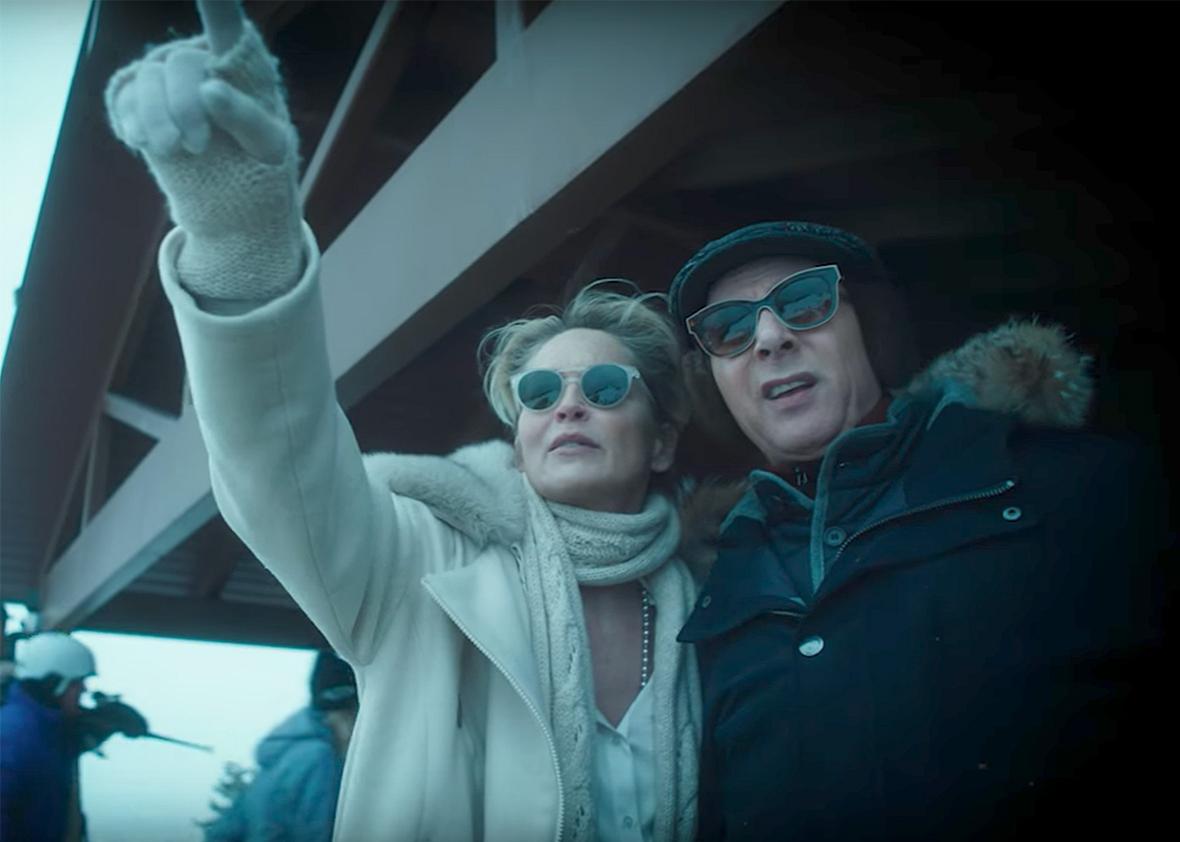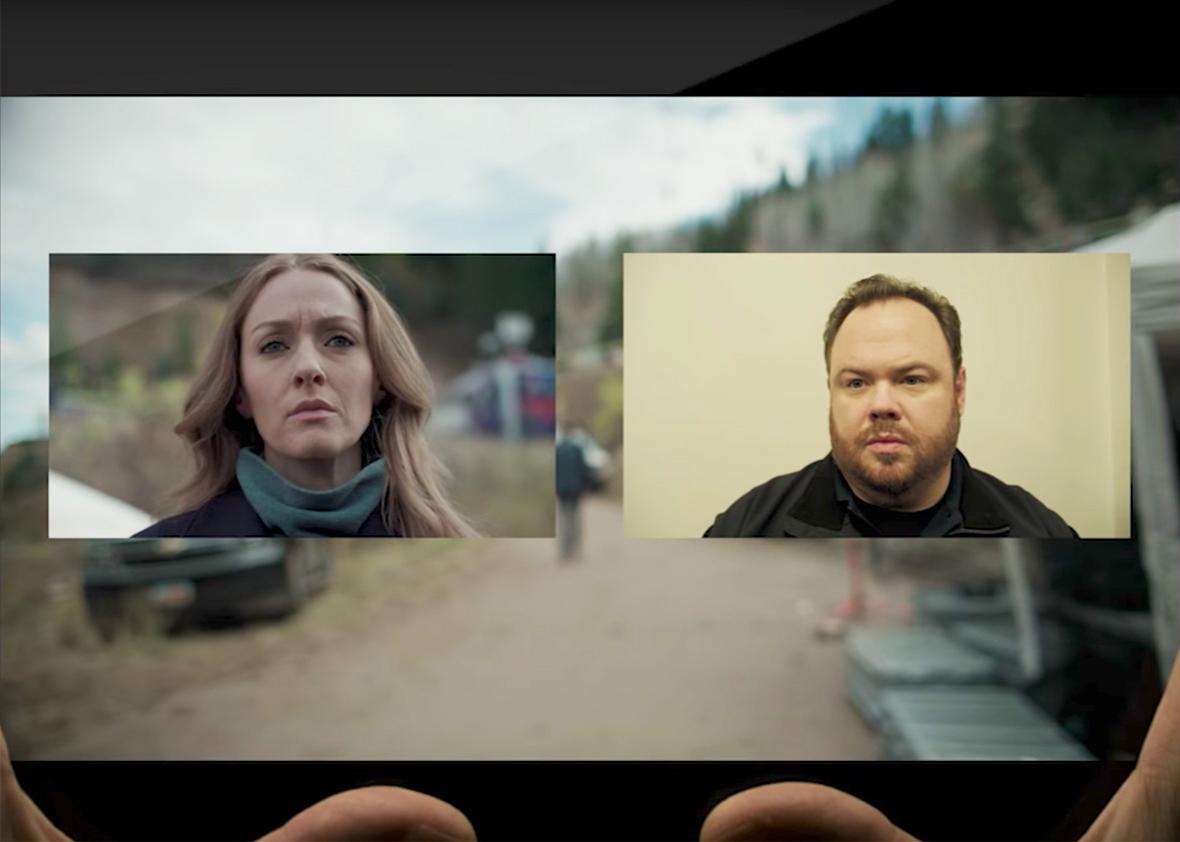Buffy the Vampire Slayer creator Joss Whedon often attributed the success of his shows to his writing philosophy: “Don’t give people what they want, give them what they need.” Even allowing for fan feedback, most television still works in the way Whedon describes it, with a deitylike showrunner or pantheon of writers dictating from on high. We just watch.
Released Wednesday, filmmaker Steven Soderbergh’s latest project relinquishes some of that authorial control. With the Mosaic app, audiences get to decide how they want to watch a murder mystery about a glamorous children’s author (played by Sharon Stone) who turns up dead in a ski-resort town populated by jet-setters and their grudging servers. (The app is free for iPhone, iPad, and Apple TV users; an Android version is in the works.) At the end of each chapter (which range from eight to 38 minutes but average around a half-hour), viewers are asked to select one of two characters’ storylines. (It’s unnervingly easy to imagine a dystopian future in which pop-culture products will be A/B tested this way.)
Mosaic has often been compared with the Choose Your Own Adventure books (a ubiquitous description that happens to make Soderbergh blanch), but it’d be more accurate to call the app a Choose Your Own Protagonist menu. Users’ picks have no bearing on the outcome of the plot; the destination is more or less the same. But they can opt for their preferred companion(s) during their journey.
The app contains 7.5 hours of video, six of which have been cut into a traditional, linear miniseries for HBO that debuts on Jan. 22. Soderbergh seems to prefer the app version, but making my way through Mosaic, I found myself increasingly wishing for a more passive watching experience. Whedon is right: I started resenting what I wanted and missing what I needed. And what I need, it turns out, are better execution of an ambitious idea, plus the kind of masterful craftsmanship that makes serialized storytelling an addiction instead of a slog.
I should point out here that, while criticism is always a subjective endeavor, the array of choices that Mosaic forces on users makes it extremely unlikely that any reader will watch the exact same story that I did. After the first chapter, “Meet Olivia Lake,” which introduces us to Stone’s man-eating, youth-chasing, fortune-squandering philanthropist, I faced a choice: Continue with the seduction scam that con man Eric (Frederick Weller) is pulling on the older woman, or learn more about Olivia’s volatile tenant Joel (Garrett Hedlund). At each turn of the snowy noir, I followed my instincts: I love grifts and female characters. And so I followed Eric’s plotline, and when he ended up in prison for Olivia’s murder, I accompanied his amateur-sleuth sister Petra’s (Jennifer Ferrin) efforts to exonerate him.

Sharon Stone and Paul Reubens in Mosaic.
HBO
It wasn’t very fun. With all chapters helmed by Soderbergh, Mosaic boasts the director’s assets and suffers from his weaknesses. As expected, the filmmaking is elegant and moody, with a sustained interest in the ways money twists up lives and some very swanky architecture porn. It’s also impersonal bordering on cold, with little regard for character development. (Now You See Me scribe Ed Solomon penned the script.) If all you want out of a TV series is steady plot progression, Mosaic offers that in spades. But during the three or so hours it took me to get through the story from start to finish the first time, I was frequently frustrated by the lack of thematic and character throughline, not to mention Ferrin’s less-than-compelling performance. I felt like I was missing narrative and emotional fulcrums—a suspicion confirmed when I later toured the roads not taken. Those pockets of plot I’d skipped over certainly encourage greater exploration within the app. But as a viewing experience, well, I already watch enough bad TV.
It’s possible I would have had a better time had I chosen Joel instead of Eric after the introductory installment. Along with Stone, Paul Reubens as Olivia’s gay bestie and Beau Bridges as a possibly corrupt ex-sheriff, Hedlund is one of the few actors in Mosaic with a distinct and memorable presence. Hunky Joel’s backstory makes his rift with Olivia all the more tragic, but he’d barely registered when seen through Petra’s eyes. Alas, my choices had been wrong.
Mosaic was written to be watched in a variety of ways, but the more chapters you take in, the richer (and more logical) it gets. Still, the time-jumping disjointedness of my first watch made me newly appreciative of the narrative peaks and valleys inherent to episodic storytelling. An app-specific feature called “discoveries” supplemented the chapters with short video, audio, and documents, like footnotes in a novel. But they felt mostly unnecessary and distracted me from the main plot with redundant flashbacks. And the thrill of choice diminished as I began to lose interest in the procedural. (The identity of the murderer is surprisingly anticlimactic.)
Soderbergh himself calls Mosaic the “cave painting of this format,” and it’s hard to disagree. Perhaps it’ll be remembered in the future as one of the first major experiments in a new medium, but it doesn’t feel much like a game-changer right now: It seems doubtful that the app version will be better entertainment than the HBO edit. It’s possible we need a drastic rethinking of narrative pleasure for a story to thrive in this type of branching configuration. And maybe one day we’ll get better at choosing what we need instead of reflexively clicking on what we want.
